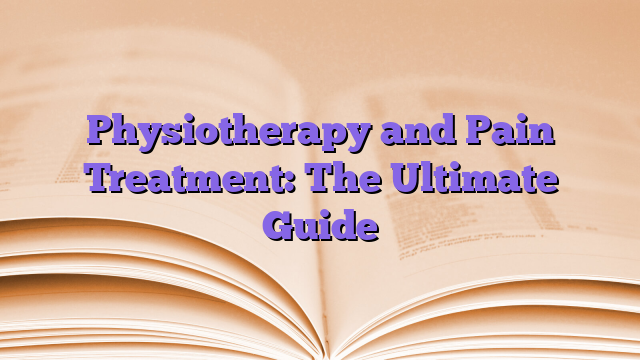
Pain Relief is one of the major objective of Physiotherapy. This article explain how physiotherapy helps in pain treatment by physiotherapy and the physical modalities that can be used for pain treatment.
“For all the happiness, Mankind can gain.
Its not in pleasure, But in relief from pain.”
John Dryden
Pain Relief is one of the major objective of Physiotherapy. And, it is a great objective as most of the population who seeks medical advice, do so after having pain of some kind or other.Physiotherapy is not an exception either.
PAIN
The word ‘pain‘ is derived from the latin poena, meaning punishment. The International Association for the study of Pain (IASP) defines pain as “an unpleasant sensory and emotional experience associated with actual or potential tissue damage, or described in terms of such damage.”
This definition clearly shows that pain has an emotional aspect associated with it. The defition also focusses on the protective role of pain as it may occur even in the presence of potential tissue damage, thus, act as a signal that the part of the body or whole body is in some form of distress.
Etiological Classification of Pain
There are two categories broadly in which pain can occur:
- Traumatological
- Pathological
TRAUMATOLOGICAL
This pain is the result of some kind of trauma. This may include:
- Trauma due to external injury e.g. pain due to fracture or pain after a soft tissue injury
- Micro – Trauma or Repetetive Stress/ Strain Injury e.g. lateral epicondylitis (Tennis Elbow), osteoarthritis knee joint.
PATHOLOGICAL
The pain is due to some kind of underlying disease process.
Pathological process can further divided into:
- Inflammatory (rheumatoid arthritis, hepatitis) or non- inflammatory(cancerous growth, hysterical pain)
- Infectious (pain in chikungunya, pain in tuberculosis) or non- infectious (Cervical or lumbar radiculopathy due to PIVD)
- Local (cystic ganglion, complex regional pain syndrome) or Systemic (gouty arthritis, ankylosing spondylitis)
- congenital (chest pain due to heart anomalies) or acquired
Effects of Pain on quality of life
There are some factors that can act as markers while giving the therapy, so that clients own views can be considered about physiotherapy treatment outcomes. This is specially important in the patient centered – model of treatment.These markers are:
- Physical functioning
- Social functioning
- Psychological distress/ well- being
- Health perception (general)
- Bodily Pain
- Energy/ fatigue
- Sleep pattern
- cognitive functioning
Measurement of Pain
The simplest and the most reliable scale for pain measurement before and after physiotherapy-treatment is Visual Analogue Scale (VAS). It require that the patient will rate his pain on the scale with markings from 0-10.
No distress 0| | | | | | | | | | |10 Unbearable distress
Philosophy for Pain Treatment
The role of physiotherapy in pain treatment spans the settings of inpatient, outpatient and home treatment. The approach to patient care must be interdisciplinary, and must include other medical professionals and allied health care professionals and allied health care professionals. Presently, patient- centered model is followed and the patient’s satisfaction is the foremost thing. But the equal importance must be given to restore function, patient’s education and prevent recurrent injuries.
Modalities for Pain Treatment
Physical modalities used by Physiotherapist for treatment of pain:
Stretch
- Sustained and selective stretching
- Hold- Relax PNF pattern
- Contract- Relax PNF pattern
- Post- isometric relaxation
Strengthening
- Isometric
- Isotonic – Concentric and Eccentric
- Isokinetic
Endurance Exercises
Superficial thermal modalities
- Hot packs (Hydrocollater or moist packs)
- Paraffin Wax Bath
- Heat Lamps
Deep thermal modalities
- Ultrasonic therapy
- Shortwave Diathermy
Superficial cold
- Ice massage
- Ice packs
- Cryo- sprays
- Cryo- compression units
Electrical modalities
- Transcutaneous electrical nerve stimulation (TENS)
- Interferential therapy (IFT)
Bracing
- Resting
- Functional
Assistive devices
- Devices that helps in mobility
- Devices that helps in activities of daily living
Patient’s education
- Work simplification
- Energy conservation
- Joint conservation
- Back conservation
Author is the
- Head of Department, Physiotherapy, occupational Therapy at Tamana Association, Vasant Vihar, Delhi
- Owner of webportal physiolinedelhi

